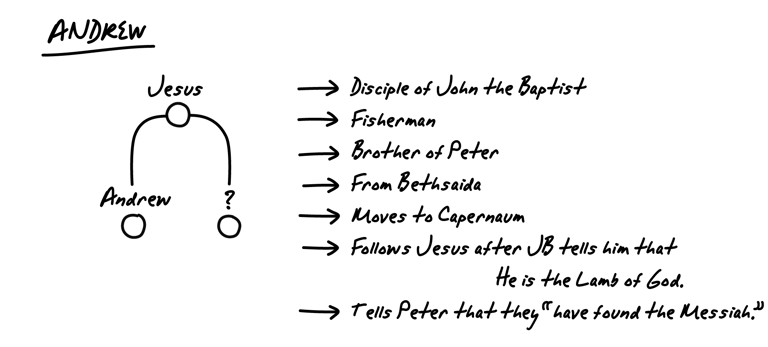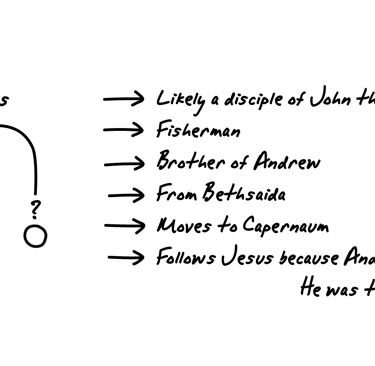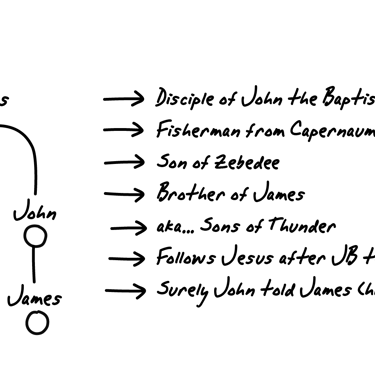How Jesus Started
Chris Lynch
3/1/20257 min read
If you’re reading this, it’s safe to assume you know Jesus, His mission, and quite a bit about His life. You probably know about His baptism, the 40 days in the wilderness, and how He started to tell the people of Israel, “The Kingdom of God has come near. Repent and believe the good news!” You might even be familiar with how the early chapters of John’s Gospel show Jesus investing in a small group of young, uneducated disciples.
As you read the Gospels, the start of Jesus’s ministry can look abrupt and random, even accidental. It’s as if He waited for 30 years to get going and then, – BOOM! – He just started telling everyone the Gospel. But I’m not sure that’s the reality. If we look deeper, we see that these first disciples were part of a connected community woven together by relationships, shared experiences, and even family ties. Understanding how Jesus started not only sheds light on His methods but also offers a model for how God’s Kingdom still grows through relationships and intentionality.
So, who were Jesus’s first disciples, and what do we know about them? Let’s look at John 1:29-51. In verse 35, we’re introduced to two disciples of John the Baptist: Andrew and some other guy. What do we know about Andrew?


He was a disciple of John the Baptist, a fisherman from Bethsaida who moved to Capernaum, a brother of Peter, and he followed Jesus after John the Baptist told him that Jesus is the Lamb of God.
Then we meet Simon Peter, Andrew’s brother. He was likely a disciple of John the Baptist with his brother, a fisherman from Bethsaida who moved to Capernaum, and he followed Jesus because Andrew told him that they “have found the Messiah.”


We get introduced to Philip abruptly when Jesus starts His trip from the Jordan River region of Judea (in the south) to the region of Galilee (in the north). John simply tells us that “He found Philip and said to him, ‘Follow me.’” But we also know that Philip was from Bethsaida, just like Andrew and Peter, and was likely a disciple of John the Baptist because he was in the Jordan River region of Judea, where John the Baptist was baptizing and where Jesus had just met Andrew and Peter.


Just like Andrew, Philip can’t keep the news that he’s found the Messiah to himself. He quickly finds Nathanael, who, evidently, was also hanging out in the same area even though he’s from Cana, a city in Galilee. There isn’t anything noteworthy at the Jordan River where they all were, except that John the Baptist was baptizing there. So it seems very likely that Nathanael was a disciple of John the Baptist as well.


And there’s one other guy that we missed. Back in verse 35, John tells us about two guys with John the Baptist. One was Andrew. Who is this other man of mystery? John refers to a nameless man multiple times in his Gospel.
John 13:23 – “One of his disciples, whom Jesus loved, was reclining at Jesus’ side…”
John 20:2 – “So she ran and went to Simon Peter and the other disciple, the one whom Jesus loved…”
John 20:4 – “Both of them were running together, but the other disciple outran Peter and reached the tomb first.”
John 21:20 – “…the disciple whom Jesus loved…”
Then he finally names this man of mystery in the last sentences of his Gospel. “This is the disciple who is bearing witness about these things, and who has written these things” (John 21:24).
At least back to the 2nd Century, the authorship of the Gospel is attributed to John, son of Zebedee, brother of James. It’s a pretty safe conclusion that the mystery man in John 1:35 is John himself, in all of his humility.
That would mean that John, the author of this text, was first a disciple of John the Baptist. We also know that he was a fisherman from Capernaum, one of the sons of Zebedee, along with his brother James, and they were known by many as the “Sons of Thunder.” James and John were close because they were brothers and in business together. They were also business partners with Andrew and Peter (Luke 5:10).
Wait … what? How did I miss that? Peter, Andrew, James, and John were all business partners, and we know that Peter, Andrew, and John were definitely disciples of John the Baptist. Surely John found his brother, James, as quickly as possible to tell him that they had “found the Messiah!”


We’ve now been introduced to five of Jesus’s closest disciples (possibly six, but we don’t know when John would have been able to tell James), and these guys don’t seem to be all that random. They’re from the same region, some of them are related, some are business partners, and they’re all disciples of John the Baptist.
And who was John the Baptist? He was a relative of Jesus (Luke 1:36); their mothers were related and close enough that when Mary found out that Elizabeth was pregnant, she immediately went to be with her until John the Baptist was born (Luke 1:36, 39-40, 56). How could Jesus and John the Baptist have grown up not knowing each other? There’s the whole relative thing, but there’s also what the angel (the same angel, by the way) told their parents.
Angel Gabriel to Mary: “(Jesus) will be great and will be called the Son of the Most High. And the Lord God will give him the throne of his father David, and he will reign over the house of Jacob forever, and of his kingdom there will be no end.” (Luke 1:32-33)
Angel Gabriel to Zechariah (Elizabeth’s husband): “He will be great before the Lord…and he will turn many of the children of Israel to the Lord their God, and he will go before him in the Spirit and power of Elijah, to turn the hearts of the fathers to the children, and the disobedient to the wisdom of the just, to make ready for the Lord a people prepared.” (Luke 1:15-17)
When Zechariah was finally able to tell people about what was going on, he sais, “And you, child, will be called the prophet of the Most High; for you will go before the Lord to prepare his ways, to give knowledge of salvation to his people in the forgiveness of their sins, because of the tender mercy of our God, whereby the sunrise shall visit us from on high to give light to those who sit in darkness and in the shadow of death, to guide our feet into the way of peace.” (Luke 1:76-79)
Come on! Can you imagine Zechariah’s excitement when he heard Mary talking about Gabriel’s message to her, only six months after Zechariah heard this message from Gabriel? And he couldn’t tell anyone! It would be really hard for me to believe that Jesus and John the Baptist didn’t grow up together in some way, with their parents telling this story all the time.
So now we have these five guys who left their homes … Oh, yeah! All of these guys are from Galilee, up there in the north, but in John 1 they’re in the south, east of the Jordan River, just above the Dead Sea (John 1:28). They all left their homes and their work for periods of time to follow Jesus’s relative who Gabriel said would “turn many of the children of Israel to the Lord their God” and is “proclaiming a baptism of repentance for the forgiveness of sins” (Luke 3:3). Then Jesus said to these guys, “Come stay where I’m staying” (John 1:39). And the next day, when He headed out for Galilee, they went with Him.
With everything we now know, it doesn’t seem so strange that they bailed on John the Baptist so quickly, but what we find out in John 2:1-2 absolutely catches me off guard. Jesus was headed to this wedding in Cana, and His mom had been invited, AND His disciples had been invited! But just days earlier, these guys weren’t the disciples of Jesus. They were the disciples of John the Baptist. In fact, Jesus didn’t have ANY disciples a few days before. Their social circles were so close that they were already invited to the same wedding. And that’s not all! Who’s from Cana? Nathanael! One of the five! There’s no way these guys were random. They were part of a tight relational network – “oikos” – with each other and with Jesus.
This isn’t the only oikos that Jesus tells the good news, but most of His oikos reject Him as Messiah (His hometown of Nazareth – Luke 4:14-30, His brothers – John 7:5, Mark 3:31-35). Still, the early part of Jesus’s ministry was clearly built on the good news taking root in His relational network.
Maybe we easily miss the way Jesus started because too often the Gospels aren’t read with the context of God’s mission in mind. Maybe we miss how Jesus started because the Kingdom grows so quickly that it’s easy to look past this simple start. Or maybe we miss how He started because the work of Jesus’s death and resurrection is so profoundly life-changing for each of us. But once you see this and the pattern that follows in Scripture, it will change the way you see any ministry starting.
Jesus’s start was anything but random. These first disciples weren’t strangers. They were part of an interconnected oikos prepared by God for this mission. From the Jordan River to the wedding at Cana and the shores of Galilee, Jesus’s ministry was built on relational trust and intentionality.
As I consider His ways, I’m reminded of the many, many times I’ve seen the Kingdom of God grow through the natural connections in the lives of disciples. Just as Jesus found the first disciples in His relational network, He invites us to step into the same pattern of making disciples, trusting that God has already woven the threads of His mission into the fabric of our everyday relationships.
Subscribe for Updates
© 2025. All rights reserved.
All financial contributions are processed and handled by Allegro Solutions (Houston, TX).
Allegro is a charity in the USA, only, under 501(c)(3) of the Internal Revenue Code.
Receipts for all donations will be issued by Allegro Organizational Solutions, Inc.
Fiscal Sponsor
Organization
Chris & Angie are sent from mvmt network - a decentralized network of disciples, churches, and leaders - with accountability to the elders of the network and the apostolic bands that they serve with.